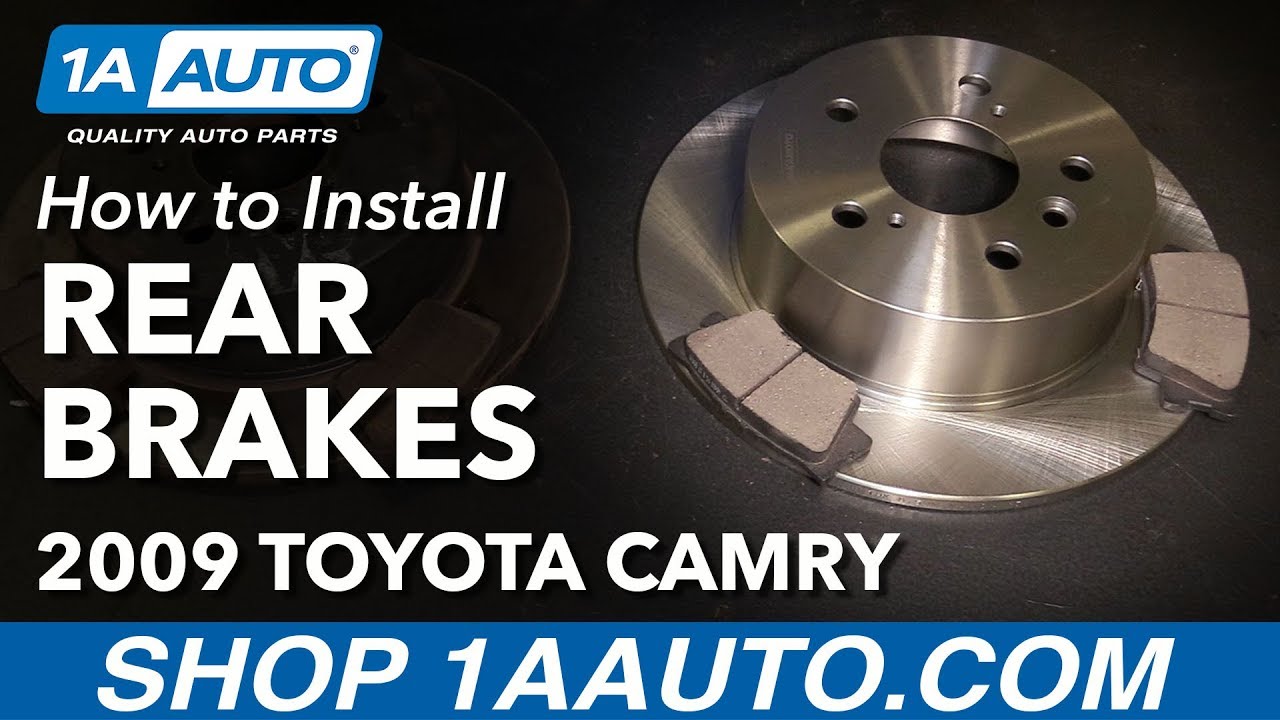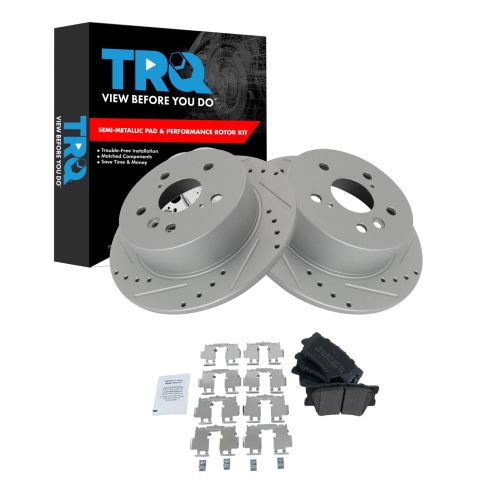
How to Replace Rear Brakes Pads Rotors 2007-11 Toyota Camry
Created on: 2017-10-24
If the rear brakes are worn, faded, or failing, this video will show you how to replace them yourself
Tools needed
-
Large C-Clamp
Torque Wrench
Rust Penetrant
Pry Bar
Jack Stands
Complete Metric Wrench Set
Brake Parts Cleaner
Rubber Mallet
Flat Blade Screwdriver
Bungee Cord
Anti-Seize Grease
Wire Brush
Floor Jack
Cloth Rags
Complete Metric Socket Set
Hi. I'm Mike from 1A Auto. We've been selling auto parts for over 30 years.
Use a pry bar, or a large flat-bladed screwdriver to remove the hubcap. Just gonna slide it under the edge. Put that aside. Take a breaker bar and a 21 millimeter socket, and loosen the lug nuts with the car still on the ground.
Raise and support the vehicle. Now you can finish removing the wheel. These lug nuts are pretty loose, so I'm just going to use the socket and take them off. I'm removing the last lug nut. I'm just going to hold onto the wheel so that it doesn't fall off and take it right off.
Start by removing the two caliper pin bolts--one on the bottom and one on the top. Use a 14 millimeter. It actually broke free without having to use the mallet.
If it's tight, you can take a mallet and just tap it to break it free. You can squeeze the caliper a little bit by pulling it out. It should slide right off the pads. Take a bungee cord and just hang it up and out of the way.
So I'm going to use a small pry bar, or you can use a flat-bladed screwdriver. You need to pop them away from the brake rotor and out of the caliper bracket. Remove the caliper bracket bolts. There's two at the back--one on the top and one on the bottom. They're 14 millimeter. They can be in there pretty tight. Use a box wrench and a mallet and break them free.
Going to get the bottom one loose and then work on the top one. See that they've broken free--you can switch to a ratcheting wrench. Got it pretty loose, just got to remove the bottom one with my fingers. Put that aside and reuse it, and get the top one out. Pull the bracket out, and the bolt out.
This car is missing a rubber plug that goes in the rotor here. The rubber plug is so you can access the parking brake mechanism to release it. Somebody just put some duct tape over it. I'm going to peel it off. Inside here is the mechanism. I'm going to try to pull it off first, though, 'cause sometimes it's loose enough, you don't need to release it.
Parking brake's not on--it is spinning free. I can spray some rust penetrant around the hub. A little bit in here. We'll take our dead blow mallet. I'm gonna hit around the edge here to try to break it free.
Sometimes you'll get lucky. These might come off, but they usually get stuck on the parking brake shoes. Need to release the adjustment. It's very hard to see right now, but through this opening, it normally has a rubber plug on it. It had some duct tape on it. We removed it. Take a flat-bladed screwdriver. We're gonna spin it. Trying to grab the little tabs on there and spin it up, it's in a little wheel. Make sure I'm going the right way. You can check and see I went the wrong way. It locked it, so it's going to be actually spun down.
You basically just have to spin that wheel down and keep retracting the parking brake shoes in, so the converter will come free. When you adjust it, you're going through the rotor and into this hole, and then you're pushing down on it. And that spins the parking brake shoes in to release them.
Here's our original pads and rotors from our vehicle, our brand new ones from 1AAuto.com. Same exact style of rotor. Pads are same design--same lug pattern, pusher bolts, holes if you need to, the same access hole for the parking brake, which rides on the inside of the brake rotor hub here. These should fit great and work great for you.
We're going to clean and reuse our brake caliper hardware. It's in the caliper bracket, and I'm going to use the brake parts cleaner. Let's take a wire brush. Use the brake parts cleaner and a rag, and just wipe it down. Typically this hardware is stainless steel, so it can be reused. It doesn't get very rusty. And repeat it for the other side.
Now's is a good time while we have this out, just make sure that your caliper slide pins move freely. These ones move nice and free, and we install that in the car. Install the rotor backwards, take brake parts cleaner, and clean off the oil that comes on these so they don't rust while they're shipped.
Flip it over. Make sure you install it in a way that this hole lines up with one of the openings here so you can adjust the parking brake. Instead of taking the caliper off of our bungee cord, I'm going to take one of the old brake pads, take a ski clamp. And now what I'm going to do is gently compress the caliper, push the piston into the body, and that way when we put our new pads in it'll slide right together. I'm just going to rest the caliper like that.
Take a brake parts cleaner and clean it off. Reinstall our caliper bracket, keep the top one caught first, and it makes it a little bit easier. And I'm going to install the bottom one. It's a little easier, 'cause it just hangs on the top one. Reach in behind here. Put that bracket lined up.
Use the 14 millimeter ratcheting wrench to snug these up. Install our new pads. Just take some brake parts cleaner and make sure they're nice and clean. Brake caliper grease on the ears of them. Inside and outside pads are the same. Let's start with the inside pad. Place it on the bottom clip and push it up into the top clip. It snaps into place. Do the same for the outside one.
We're just following the curve of the pad too, the contoured, so the wider part is gonna match up with the lighter outside part of the rotor--same with the inside part. Just push them down into the clips and squeeze them together. Place the caliper back in place. Reinstall the bolts. Tighten these up. They'll get tight and I will stop.
Torque the caliper bolts to 46 foot-pounds. You need to adjust the drag on the parking brake. You can turn this so you can see the adjuster and then you can put your screwdriver in and just catch the gears in the wheel just right.
So now that's how you'd adjust it so that it's actually really tight. It's holding the brake runner, so now you know where the limit is. You want to back it off a little bit by turning it back down. Eventually if you touch the parking brake pedal it would self adjust out, but this way it just gets it closer right away.
So now I'm going to reach in and turn it down a little bit. So what it's dragging on right now is just the brake pads, but that should spin freely enough. And of course when you hit the parking brake pedal, it should come out and lock the rear wheels.
It's important to note these lug nuts have a taper, taper meets the wheel, matches the inside of the wheel. Don't install them with the flat side like this--that is incorrect. Install them with the taper to the wheel, it helps locate the wheel on the lug nut stud.
I'm just using the socket and ratchet to bring these down snug before I put the car on the ground.
We'll torque the lug nuts to 76 foot-pounds. Going in a cross pattern. We reinstall the hubcap. It'll line up the opening for the valve stem, with the valve stem on the wheel. Just push it in place.
Before we start the car, just going to gently press the brake pedal down, not all the way to the floor, maybe about a quarter of the way, and just pump it, and this will bring the brake caliper piston out to meet the pads, because we can press it, and you'll start to feel it get more solid as it pumps up.
Thanks for watching. Visit us at 1AAuto.com for quality auto parts, fast and free shipping, and the best customer service in the industry.
Shop Products
 Toyota Pontiac Scion Front Driver & Passenger Side 2 Piece Premium G-Coated Performance Brake Rotor Set TRQ Performance BRA74690
Toyota Pontiac Scion Front Driver & Passenger Side 2 Piece Premium G-Coated Performance Brake Rotor Set TRQ Performance BRA74690
 Toyota Rav4 Lexus HS250h Rear Driver & Passenger Side 2 Piece Premium G-Coated Performance Brake Rotor Set TRQ Performance BRA74917
Toyota Rav4 Lexus HS250h Rear Driver & Passenger Side 2 Piece Premium G-Coated Performance Brake Rotor Set TRQ Performance BRA74917
 Toyota Lexus Scion Front Driver & Passenger Side 2 Piece Premium G-Coated Performance Brake Rotor Set TRQ Performance BRA74913
Toyota Lexus Scion Front Driver & Passenger Side 2 Piece Premium G-Coated Performance Brake Rotor Set TRQ Performance BRA74913
 Toyota Avalon Camry Lexus ES350 Rear Ceramic Premium G-Coated Performance Brake Pad & Rotor Kit TRQ Performance BKA12105
Toyota Avalon Camry Lexus ES350 Rear Ceramic Premium G-Coated Performance Brake Pad & Rotor Kit TRQ Performance BKA12105

Toyota Avalon Camry Lexus ES350 Rear Semi-Metallic Premium G-Coated Performance Brake Pad & Rotor Kit TRQ Performance BKA12106
Part Details:
- Premium Posi
- Semi-Metallic
- 11.06 in. (281mm)
- Solid
- Performance
- 5 Lug
- Premium G-Coated
- (1) Rear Semi-Metallic Brake Pad Set with Contact Point Grease & Hardware
- (2) Rear G-Coated Performance Brake Rotors
- Slotted X Drilled
- Performance

How to Replace Rear Brakes 2001-05 BMW 325Xi
Learn what steps are needed to remove the old rear brakes and prepare and install new ones with this how-to video


